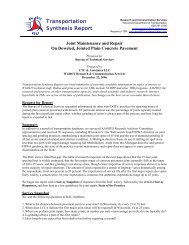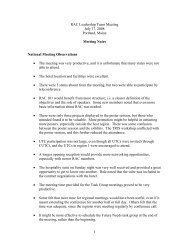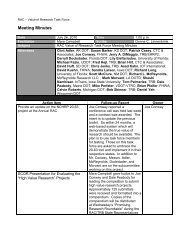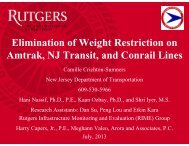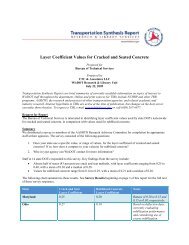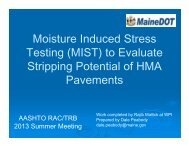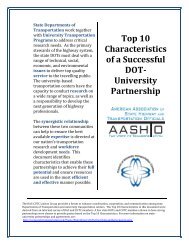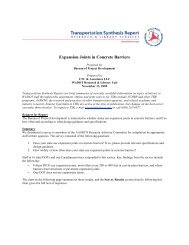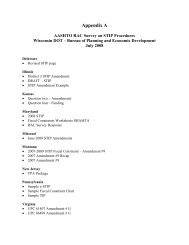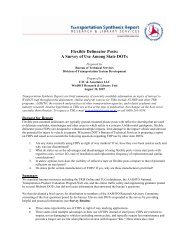PART IV: Summary of Comments - SCOR/RAC
PART IV: Summary of Comments - SCOR/RAC
PART IV: Summary of Comments - SCOR/RAC
Create successful ePaper yourself
Turn your PDF publications into a flip-book with our unique Google optimized e-Paper software.
<strong>PART</strong> <strong>IV</strong>: <strong>Summary</strong> <strong>of</strong> <strong>Comments</strong>17-May-10Reviewer <strong>Comments</strong> Distribution <strong>of</strong> Ratingscompleted FHWA study addresses the use <strong>of</strong> FWD data for rigid pavements in the MEPDG design process.Research Advisory Committee■ Ohio would be interested in the results but undertaking this research project before we finalize our move to the fallingweight deflectometer might be premature.■ In comparison to the other problem statements reviewed, this ranks low on the priority list. Furthermore, the reviewersindicated that several studies <strong>of</strong> this type have already been conducted.■ Beneficial study to those states possessing significant miles <strong>of</strong> rigid pavement.Other■ [Rating: 3.5] A lack <strong>of</strong> quantified data to support strict guidelines is needed. This has a pr<strong>of</strong>ound effect on measuredcorner deflections and LTE. However, budget is too low and will probably not improve the body <strong>of</strong> knowledge thatalready exists unless expanded.Item #100:G-30Data Fusion for Improved Detection <strong>of</strong> CongestionOnset and Travel Time Estimation(17)(46)NR 0 1 2 3 4 5<strong>SCOR</strong> 5 5 3 3 1<strong>RAC</strong> 1 4 12 15 9 5 3Standing Committee on Research■ This is an extremely academic piece <strong>of</strong> research that would be better funded by NSF.■ Agree with TRB comment. The transferability <strong>of</strong> results are limited.■ Work will newly apply two seemingly relevant statistical theorems to the problem <strong>of</strong> congestion prediction. See attachedcomments.■ [Rating: 4] Proprietary data and algorithms are black boxes which one must buy on faith. It is better to use data andalgorithms that one knows the algorithms and methods for. Travel Time Estimation and vehicle classification capabilities<strong>of</strong> sensor are reaching new heights with the techniques developed under NCHRP 3-79a and the development <strong>of</strong> vehiclesignature sensors by Reno A&E, Eberle Design. and Sensys. In addition, the development <strong>of</strong> travel time sensors usingBluetooth signals by TRAFFAX corporation.allows an Intellidrive like traffic probe sampling data set to be constructed.The data fusion algorithms and techniques described in this proposal have been and are being successfully used in theDoD environment. The data fusion technologies described in this proposal combined with the 3-79a techniques wouldmake the construction <strong>of</strong> accurate travel time and congestion measures a “simple” turn <strong>of</strong> the crank. These approachescould then later be relatively straight forwardly adapted to add Intellidrive to the data fusion.Research Advisory Committee■ Detection and travel times are always a challenge.■ As GDOT provides trip time info already, the results <strong>of</strong> this research could be very useful to the Navigator system■ Private probe data companies have probably already conducted this analysis or could do it in a short time frame.■ Too mathematical without any real-world applications described■ Suggest instead the NCHRP Reliability IDEA program to address this need.■ Based on emerging technologies, I feel that it is important that we publish travel time/congestion information in a timelymanner. My main concern is this proposal is so complex that I don’t know how the final report will be comprehended.Other■ Generally related to Reliability and Capacity, especially C05 and L03 and L02<strong>IV</strong>-73



